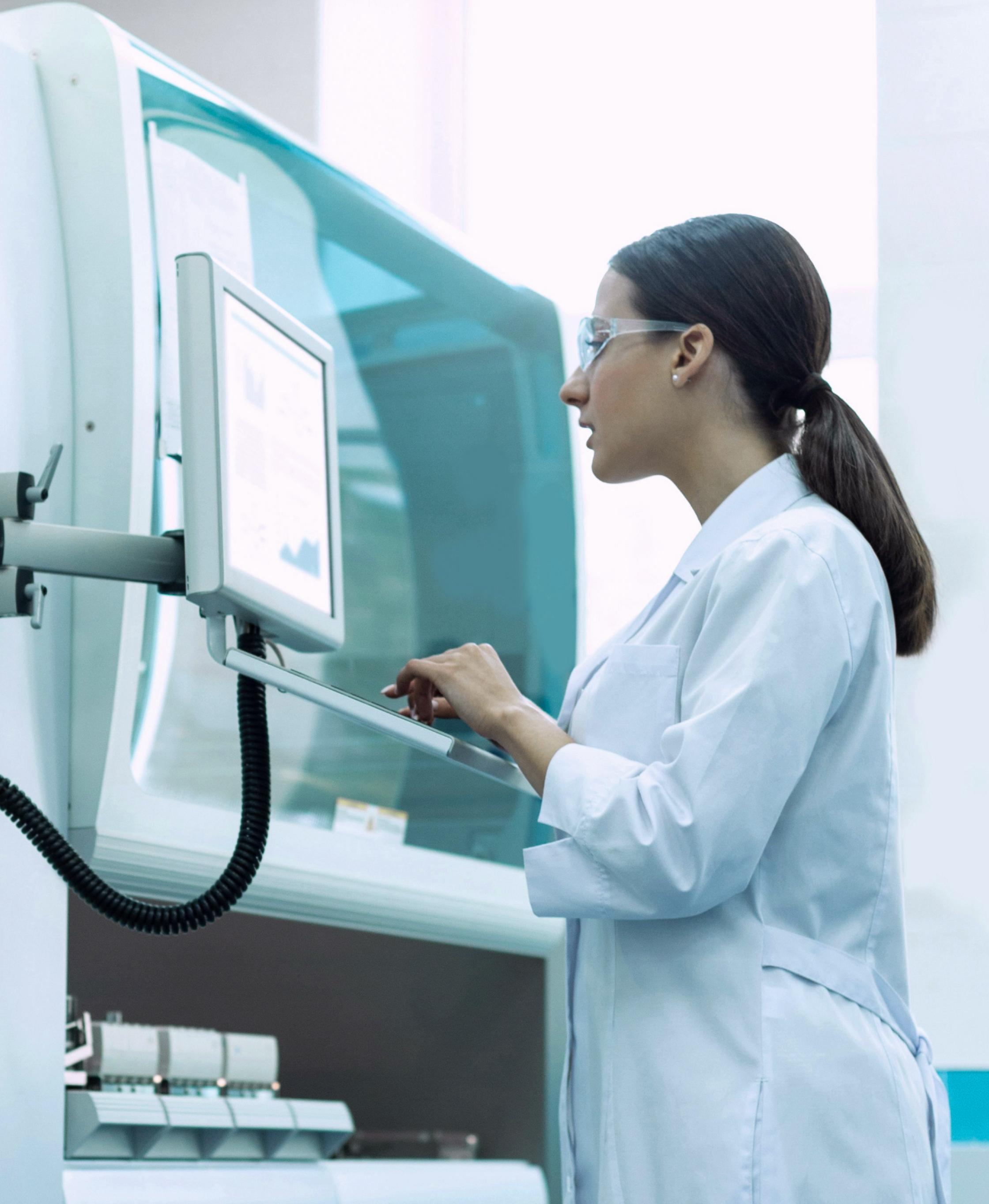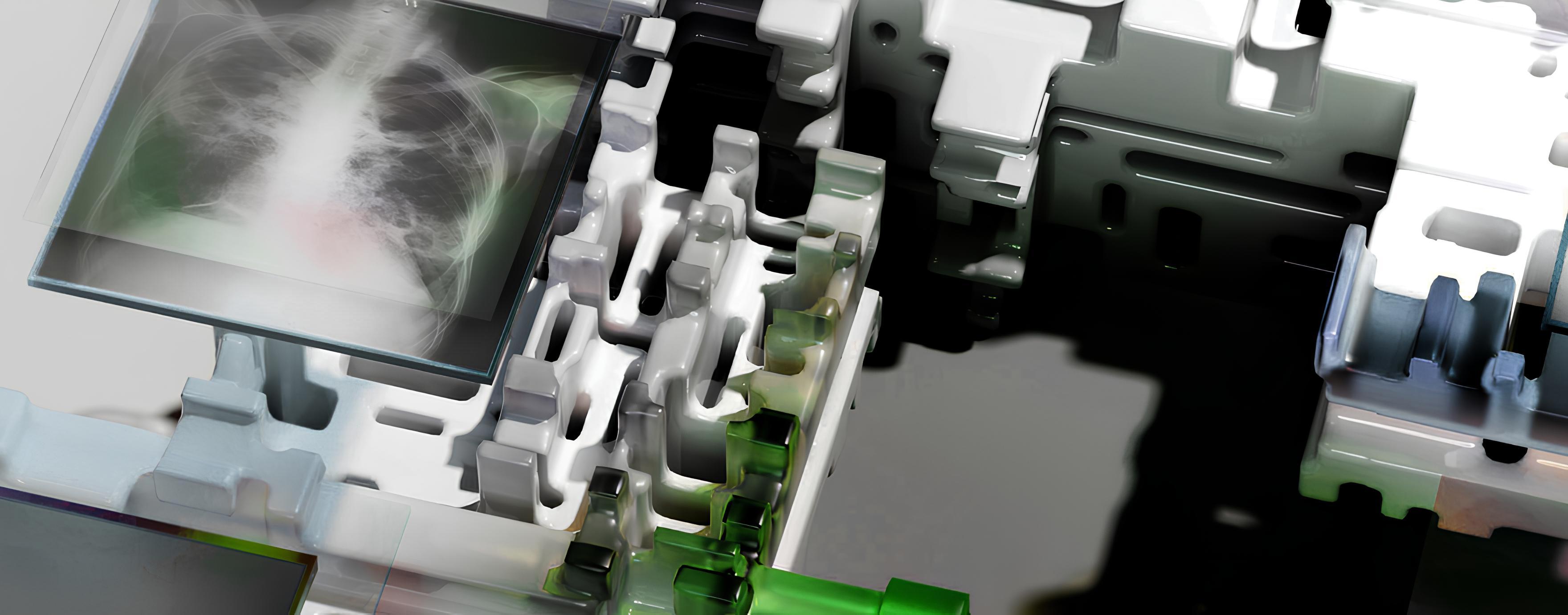Medical imaging software development

Medical imaging is at the heart of accurate diagnosis and treatment, and effective digital medical software enhances every aspect of this process. Vention specializes in medical image analysis software development, empowering you to create advanced AI- and ML-powered solutions that improve diagnostic precision, minimize errors, optimize costs, and ensure compliance with industry standards.
Our expertise ensures that you have the best tools for efficient data interpretation and decision-making, providing you with the engineering peace of mind to focus on what matters most — your patients.
What is medical imaging software?
Medical imaging software enables medical personnel to obtain a clear picture of a patient's health from medical images, leading to better diagnoses and more accurate, quicker treatments.
It involves hardware (such as X-ray machines, CT scanners, and ultrasound machines) for acquiring medical images, as well as software for image acquisition, processing, and analysis. The software enhances image quality, automates abnormality detection, and integrates AI for advanced diagnostics.
Medical imaging software market size
With an increasing demand for imaging software in dental, cardiology, orthopedic, mammology, urology, and other healthcare industries, the global medical imaging software market share is projected to reach nearly $12B by 2029, with a compound annual growth rate (CAGR) of 7.84 percent over the forecast period.
In 2023, two segments dominated the medical imaging software market: the cardiology segment (based on application) and the 4D imaging segment (based on imaging type).
The cardiology segment, driven by the high prevalence of cardiovascular and congenital heart diseases and government initiatives to improve treatment accessibility, commanded a 20.3 percent revenue share.
The 4D imaging segment held a 45.9 percent revenue share and is expected to maintain dominance due to ongoing technological advancements in 4D imaging technology.
Medical imaging software applications
Applications that analyze medical images now go beyond simple image viewing, offering advanced tools for diagnosis, treatment planning, and patient management.
Enhanced by AI, these applications can automate report generation, predict disease progression, personalize treatment, and provide real-time patient monitoring.
Diagnostic imaging software
Software for imaging diagnostics is used to visualize and analyze data, enabling medical personnel to better diagnose diseases. It includes:
-
Picture archiving and communication systems (PACS): for storing, retrieving, managing, and displaying medical images;
-
Radiology information systems (RIS): for managing radiology department workflows;
-
Specialized diagnostic software: for reading and interpreting specific types of scans like mammograms or CT scans.
Image processing software
Medical image processing software is designed to enhance the clarity, contrast, and details of initial rough medical images. It allows clinicians to see the patient's condition clearly and detect abnormalities. Filters, image reconstruction, contrast, and brightness adjustments make body structures more distinguishable.
3D visualization and reconstruction
Applications that convert CT or magnetic resonance imaging (MRI) scans into three-dimensional models help physicians precisely analyze a patient’s anatomy and pathology. These tools are widely used in surgery to plan operations on complex fractures.
AI and ML applications
Medical imaging apps enhanced with AI and ML models automate the identification of patterns associated with cancer, brain anomalies, and cardiovascular disease, enabling faster and more accurate diagnoses.
Remote imaging software
With cloud-based medical imaging software, doctors can securely and quickly share medical images among medical teams and specialists, allowing for remote consultations and teleradiology services.
Radiation therapy planning software
Software for radiation therapy planning helps design and simulate treatments, making them more effective and less damaging to surrounding healthy tissues. It connects with linear accelerators to target treatment areas and accurately plan radiation dosages.
Quantitative analysis software
Apps used for quantitative analysis offer tools to measure and quantify various aspects of medical images, such as tumor size and growth over time, blood flow, and tissue and bone density assessments from X-rays.
Reporting and documentation software
Documentation software streamlines the creation of reports based on the analysis of medical images. Enhanced by AI models, it can automatically generate detailed reports with photos, annotations, schemes, and diagnostic information, saving time for radiologists and other medical personnel.
Technologies powering medical image analysis solutions
As an international standard for storing, transmitting, and receiving medical images for clinical use, Digital Imaging and Communications in Medicine (DICOM) ensures seamless synchronization and compatibility across numerous medical devices used in radiology, cardiology, dentistry, and radiotherapy.
Image processing algorithms
Image processing algorithms enhance the quality of medical images, extracting information or transforming them for better visibility and interpretation by medical specialists. These algorithms employ denoising, contrast enhancement, edge detection, and segmentation techniques.
3D visualization and volume rendering
Medical imaging 3D visualization software and volume rendering convert 2D image slices from CT and MRI scans into detailed 3D representations of anatomical structures, which facilitates better understanding, diagnosis, and operation planning for surgeons.
Artificial intelligence and machine learning
Trained on vast amounts of image data, AI and ML play a crucial role in prediction and pattern recognition. Automation allows doctors to identify abnormalities at the earliest stages of the disease and predict its progression more easily.
Cloud computing and big data
Storing large volumes of medical data can be costly and raise security concerns. Cloud computing and big data address these issues by enabling secure telemedicine, allowing medical images to be shared across distant locations, and applying big data techniques for research and personalized medicine.
Virtual and augmented reality
VR and AR technologies offer valuable interactive experiences for medical education, providing safe, cost-effective environments for learning. By integrating 3D images into these virtual reality experiences, medical students can learn anatomical details, understand various patient conditions, and simulate potential surgical scenarios.
Quantitative imaging
Imaging quantification measures and tracks pathological features in medical images. By providing objective data, this technology supports clinicians in making accurate diagnoses, planning treatments, and monitoring disease progression.
AI benefits in medical imaging
Early and precise detection of abnormalities in medical images can significantly improve therapy outcomes, reducing effort, cost, and treatment time. While the human eye may miss subtle patterns, AI algorithms consistently identify and highlight areas that need attention.
AI can analyze more information than humans, doing so quickly, efficiently, and accurately. In emergencies, this saves doctors valuable time facilitating prompt treatment.
Improving a patient’s emotional well-being improves treatment outcomes. AI helps minimize patient discomfort and anxiety with faster diagnoses and personalized treatment plans, reducing the number of unnecessary procedures.
AI boosts the efficiency of medical imaging equipment and resources and reduces the need for repeat scans and unnecessary, costly tests.
Prevention is always better than treatment. Beyond diagnosis, AI can analyze imaging data to predict the risk of developing certain conditions, facilitating a shift toward proactive and preventative healthcare models.
AI's capacity to quickly process and analyze extensive imaging datasets significantly speeds up medical research, aiding in discovering new treatments and a better understanding of diseases.
AI insights from medical images
Tempus has rolled out its Pixel technology to provide AI-enabled insights from medical images. This tool automates the quantification of long-axis and short-axis measurements, tracks lesion reports over time, and automatically integrates these reports with patient records in electronic medical records (EMRs).


Ultrasound AI imaging in cardiology
Caption Health has developed AI interpretation technology for cardiac ultrasounds, enabling any healthcare professional to capture real-time diagnostic-quality images. The AI software guides the imaging process, automatically assesses image quality, and calculates the ejection fraction.

Data standardization in medical imaging
Enlitic Curie™ develops AI deep learning products that automatically standardize, protect, integrate, and analyze data throughout various stages of the medical imaging workflow. The Enlitic framework helps radiologists reduce and streamline their workload and enhances diagnostic accuracy.
Early-stage cancer diagnostics
One of the trailblazing medical imaging software companies, Lunit, from South Korea, is making strides in saving lives by using deep learning technology in data-driven medicine. They have developed an AI-powered imaging solution that detects early-stage cancer and optimizes cancer treatment.
Their INSIGHT CXR AI solution for chest X-rays boasts an accuracy rate of up to 99 percent and facilitates tuberculosis screening.

Healthcare regulatory standards and compliance
Medical imaging software, particularly those integrated with AI or ML, must meet stringent regulatory standards to ensure patient safety and the effectiveness of medical interventions. Here are some of the key regulations:
The US Food and Drug Administration (FDA) and the Institute of Electrical and Electronics Engineers (IEEE) set guidelines and standards for developing and maintaining healthcare software.
These frameworks ensure that medical software meets rigorous safety, quality, and efficacy standards, effectively serving its intended medical purposes.
21 CFR Part 820 refers to a section of the Code of Federal Regulations that establishes the Quality System Regulation (QSR) regulations for medical devices, as enforced by the FDA. It mandates that all medical device software developed after June 1, 1997, comply with design control provisions, including planning, input, verification, reviews, and validation.
This also extends to any software that automates device production or any aspect of the quality system.
SaMD (software as a medical device) refers to software intended for one or more medical purposes without being part of a hardware medical device. The FDA provides guidelines on the development, testing, and approval process for SaMD to ensure it meets safety and efficacy requirements.
International guidelines from the International Medical Device Regulators Forum (IMDRF) offer a framework for risk categorization of SaMD based on the significance of information provided to healthcare decisions and the state of healthcare situations.
Compliance with these ISO standards is crucial when developing SaMD and embedded software in medical devices:
ISO 13485: quality management systems;
ISO/IEC 62304: medical device software life cycle processes;
ISO 14971: applying risk management to medical devices;
ISO/IEC 27001: managing and securing patient data;
ISO/IEC 82304: product safety.
On October 24, 2023, the FDA and the UK Medicines and Healthcare Regulatory Agency (MHRA) jointly released guiding principles for ML-enabled medical devices. These principles for ML Metadata (MLMD) include addressing cybersecurity threats, ensuring data privacy, and validating software libraries.
As AI and ML continue to advance in healthcare, regulatory bodies are continuously updating guidelines to address the unique challenges presented by these innovative technologies.
Medical imaging software development: our services
With over 20 years of experience in software development, we’ve delivered around 200 cutting-edge, secure, and HIPAA-compliant solutions for the healthcare industry, vision therapy, and mental health treatment. Our medical imaging software services include:
DICOM/PACS development
Our engineers develop digital imaging and communications in medicine (DICOM) viewers, editors, converters, and picture archiving and communication systems (PACS) for easy, secure, and efficient image storage, retrieval, presentation, and sharing.
X-ray and radiography software
We deliver custom software solutions for processing and analyzing X-ray images — equipped with tools for enhancing image quality, identifying pathologies — and enabling more accurate radiologists' diagnostics.
3D medical imaging software
With our dedicated AR/VR team, converting 2D images into 3D models to better visualize anatomical structures has never been easier. Our engineers create apps that enable interactive examination of organs with 3D models and, as a result, more personalized surgical treatment planning.
AI-enhanced image analysis
Our AI engineers have worked on projects in over 30 industries, and healthcare is no exception. We train ML models to recognize repetitive patterns in imaging data and detect abnormalities accurately.
With AI, medical personnel can automate the process of analyzing medical images and predict disease progression.
Ultrasound imaging software
Need solutions for better analyzing and processing ultrasound images? We’re here to help with image quality enhancements, precise anatomical measurements, and AI-powered diagnostic tools.
Echocardiography software
For echocardiography, we can introduce features for measuring cardiac chambers, wall thickness, and ejection fraction using echocardiogram images. This specialized software aids in precise analysis and more accurate heart disease diagnoses.
Orthodontics and dental imaging
We empower the dental and orthodontic industries with cutting-edge software that revolutionizes dental X-ray analysis. Our solutions let orthodontists guide patients through step-by-step treatment plans, culminating in a vivid visualization of the final result.
Ophthalmology imaging
For the ophthalmology industry, our engineers develop software that uses medical images to measure, diagnose, and monitor patients’ eye conditions and help with the timely treatment of glaucoma, cataracts, and macular degeneration.
With Vention, you get more than you can imagine
Years in healthcare software development
Completed healthtech projects for the likes of Thirty Madison and Dialogue
Engineers with AI-specific skill sets
We help ensure compliance with HL7, HIPAA, GDPR, PCI DSS, and HITECH
Expertise in AI, IoT, VR, and computer vision for healthcare
Robust security measures endorsed by an ISO 27001 certification
Delivery on time, on budget, and on scope
Guidance on selecting stacks that reduce both initial and ongoing maintenance costs
Our work
All cases

Looking to elevate your medical imaging project?
Our medical imaging product development consultants are here to help you refine, scale, and enhance your solution with AI.






